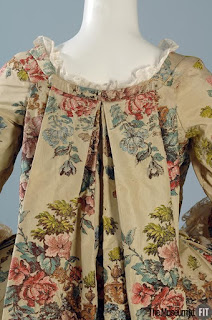One of the many problems I had with my previous Robe a la Francaise was the fact that I didn't wear stays underneath. No, I wore modern push up bra's combined with a modern corset that was 2 sizes too big (and the reason I felt compelled to wear a bra). Totally wrong silhouette and my bra kept being pushed up by the corset to the point of being visible above my neckline.
Since then I learned that the no. 1 rule of historical costuming is getting proper undergarments to achieve the proper silhouette. So I debated various stays.
You had 2 options:
Fully boned (left) - which was very strong, pushed everything in the right place and has good weight distribution
Half boned (right) - which offers more flexibility and is lighter.

After debating endlessly I decided to go for the fully boned one. I like the look of that more, also since I have bad posture the extra support doesn't hurt.
So I decided to use J.P. Ryan's strapless stays. Which are fully boned, but doesn't have the shoulder straps for more arm movement.
As for fabrics I used mostly stuff that I had in my stash. Gold silk and canvas. I didn't buy anything for these stays except the boning. I also might want to replace the ribbon I used for lacing, but this is a worry for another time.
You can see on the picture below a cotton canvas base I once tried to turn into panniers until I dropped that project. I could use it now for the interlining of my stays. Here you can see the pattern pieces ready for cutting
After cutting the pieces in canvas I also cut the pieces out of silk and flatlined these to the canvas parts. This would be the outer layer. An extra canvas layer would be used as interlining so the bones would be between 2 layers of canvas.
So I sewed everything together, only to find out that I needed to sew the boning channels first. However it was a good time for a small fitting. So I fit the stays before disassembling it again.
It was now time to sew the boning channels. I waited until the boning arrived, so I could check the width before sewing. Luckily I could use my sewing foot as a marker. By following the line of the first channel (or the 'future' seamline).
I could then sew it back up and put the boning in. I used reed boning for the large part, but metal boning next to seamlines for extra support. As you can see in the picture below this is a little visible, since the reed boning is curved on one side and the metal isn't. I looks like the metal is slightly bigger. Only a nitpicker like me sees this and most people won't even see the stays, since it will be under the dress.

It was then time to make the lacing holes.I usually use metal grommets, since I'm always afraid I'll tear my fabric apart. However I like the look of hand sewn eyelets. So I compromised and used metal grommets and with metallic gold thread handsewn over it. Really a lot of work. It was also the first time I used the smaller grommets. On the picture below you can see a few covered grommets and a naked one.
After this I fit the corset again and could properly lace it in, or at least with help I could. Confirming it still fit I tried to fit the lining in. This was difficult and I decided: ' Why bother?' and just left the lining and used bias binding to finish my raw edges. This was a second time for me and the first time I've done it properly.
I like the binding. I wanted to use blue satin ribbon, but this moved around too much. I did have some black cotton twill bias which I used. It's not as need as I could have made it, but who cares. At that point I just wanted the stays to be finished.
Finished
The stays in all it's glory!





























